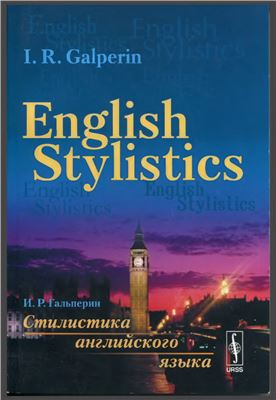М.: Либpoком, 2010, 2014. — 336 с. OCR.
I.R.Galperin. Stylistics.
Классический учебник по стилистике английского языка для
факультетов иностранных языков.
Предисловие к первому изданию.
Предисловие к второму изданию. Introduction:
General Notes on Style and Stylistics.
Expressive Means (EM) and Stylistic Devices (SD).
General Notes on Functional Styles of Language.
Varieties of Language.
A Brief Outline of the Development of the English Literary (Standard) Language.
Meaning from a Stylistic Point of View. Stylistic Classification of the English Vocabulary: General Considerations.
Neutral, Common Literary and Common Colloquial Vocabulary. Special Literary Vocabulary:
Terms.
Poetic and Highly Literary Words.
Archaic, Obsolescent and Obsolete Words.
Barbarisms and Foreignisms
Literary Coinages (Including Nonce-Words). Special Colloquial Vocabulary:
Slang.
Jargonisms.
Professionalisms.
Dialectal Words.
Vulgar Words or Vulgarisms.
Colloquial Coinages (Words and Meanings). Phonetic Expressive Means and Stylistic Devices: General Notes.
Onomatopoeia.
Alliteration.
Rhyme.
Rhythm. Lexical Expressive Means and Stylistic Devices: Intentional Mixing of the Stylistic Aspect of Words.
Interaction of Different Types of Lexical Meaning.
Interaction of Primary Dictionary and Contextually Imposed Meanings.
Metaphor.
Metonymy.
Irony.
Interaction of Primary and Derivative Logical Meanings.
Stylistic Devices Based on Polysemantic Effect, Zeugma and Pun.
Interaction of Logical and Emotive Meanings.
Interjections and Exclamatory Words.
The Epithet.
Oxymoron.
Interaction ot Logical and Nominal Meanings:
Antonomasia.
Intensification of a Certain Feature ot a Thing or Phenomenon:
Simile.
Periphrasis.
Eupnemism.
Hyperbole. Peculiar Use ot Set Expressions:
The Cliche.
Proverbs and Sayings.
Epigrams.
Quotations.
Allusions.
Decomposition of Set Phrases. Syntactical Expressive Means and Stylistic Devices: General Considerations.
Problems Conceing the Composition of Spans of Utterance Larger than the Sentence:
Supra-Phrasal Units.
The Paragraph.
Compositional Pattes of Syntactical Arrangement:
Stylistic Inversion.
Detached Construction.
Parallel Construction.
Chiasmus {Reversed Parallel Construction).
Repetition.
Enumeration.
Suspense.
Climax (Gradation).
Antithesis.
Particular Ways of Combining Parts of the Utterance (Linkage):
Asyndeton.
Polysyndeton.
The Gap-Sentence Link.
Particular Use of Colloquial Constructions:
Ellipsis.
Break-in-the-Narrative (Aposiopesis).
Question in the-Narrative.
Represented Speech:
Uttered Represented Speech.
Unuttered or Inner Represented Speech.
Stylistic Use of Structural Meaning:
Rhetorical Questions.
Litotes. Functional Styles of the English Language: Introductory Remarks:
The Belles-Lettres Style:
Language of Poetry:
Compositional Pattes of Rhythmical Arrangement:
Metre and Line.
The S tanza.
Free Verse and Accented Verse:
Lexical and Syntactical Features of Verse.
Emotive Prose.
Language of the Drama. Publicistic Style:
Oratory and Speeches.
The Essay.
Joualistic Articles. Newspaper Style (written by V. L. Nayer):
Brief News Items.
Advertisements and Announcements.
The Headline.
The Editorial. Scientific Prose Style.
The Style of Official Documents. Final Remarks.
List of Authors Referred to.
Index of Words.
Bibliography.
Предисловие к второму изданию. Introduction:
General Notes on Style and Stylistics.
Expressive Means (EM) and Stylistic Devices (SD).
General Notes on Functional Styles of Language.
Varieties of Language.
A Brief Outline of the Development of the English Literary (Standard) Language.
Meaning from a Stylistic Point of View. Stylistic Classification of the English Vocabulary: General Considerations.
Neutral, Common Literary and Common Colloquial Vocabulary. Special Literary Vocabulary:
Terms.
Poetic and Highly Literary Words.
Archaic, Obsolescent and Obsolete Words.
Barbarisms and Foreignisms
Literary Coinages (Including Nonce-Words). Special Colloquial Vocabulary:
Slang.
Jargonisms.
Professionalisms.
Dialectal Words.
Vulgar Words or Vulgarisms.
Colloquial Coinages (Words and Meanings). Phonetic Expressive Means and Stylistic Devices: General Notes.
Onomatopoeia.
Alliteration.
Rhyme.
Rhythm. Lexical Expressive Means and Stylistic Devices: Intentional Mixing of the Stylistic Aspect of Words.
Interaction of Different Types of Lexical Meaning.
Interaction of Primary Dictionary and Contextually Imposed Meanings.
Metaphor.
Metonymy.
Irony.
Interaction of Primary and Derivative Logical Meanings.
Stylistic Devices Based on Polysemantic Effect, Zeugma and Pun.
Interaction of Logical and Emotive Meanings.
Interjections and Exclamatory Words.
The Epithet.
Oxymoron.
Interaction ot Logical and Nominal Meanings:
Antonomasia.
Intensification of a Certain Feature ot a Thing or Phenomenon:
Simile.
Periphrasis.
Eupnemism.
Hyperbole. Peculiar Use ot Set Expressions:
The Cliche.
Proverbs and Sayings.
Epigrams.
Quotations.
Allusions.
Decomposition of Set Phrases. Syntactical Expressive Means and Stylistic Devices: General Considerations.
Problems Conceing the Composition of Spans of Utterance Larger than the Sentence:
Supra-Phrasal Units.
The Paragraph.
Compositional Pattes of Syntactical Arrangement:
Stylistic Inversion.
Detached Construction.
Parallel Construction.
Chiasmus {Reversed Parallel Construction).
Repetition.
Enumeration.
Suspense.
Climax (Gradation).
Antithesis.
Particular Ways of Combining Parts of the Utterance (Linkage):
Asyndeton.
Polysyndeton.
The Gap-Sentence Link.
Particular Use of Colloquial Constructions:
Ellipsis.
Break-in-the-Narrative (Aposiopesis).
Question in the-Narrative.
Represented Speech:
Uttered Represented Speech.
Unuttered or Inner Represented Speech.
Stylistic Use of Structural Meaning:
Rhetorical Questions.
Litotes. Functional Styles of the English Language: Introductory Remarks:
The Belles-Lettres Style:
Language of Poetry:
Compositional Pattes of Rhythmical Arrangement:
Metre and Line.
The S tanza.
Free Verse and Accented Verse:
Lexical and Syntactical Features of Verse.
Emotive Prose.
Language of the Drama. Publicistic Style:
Oratory and Speeches.
The Essay.
Joualistic Articles. Newspaper Style (written by V. L. Nayer):
Brief News Items.
Advertisements and Announcements.
The Headline.
The Editorial. Scientific Prose Style.
The Style of Official Documents. Final Remarks.
List of Authors Referred to.
Index of Words.
Bibliography.

